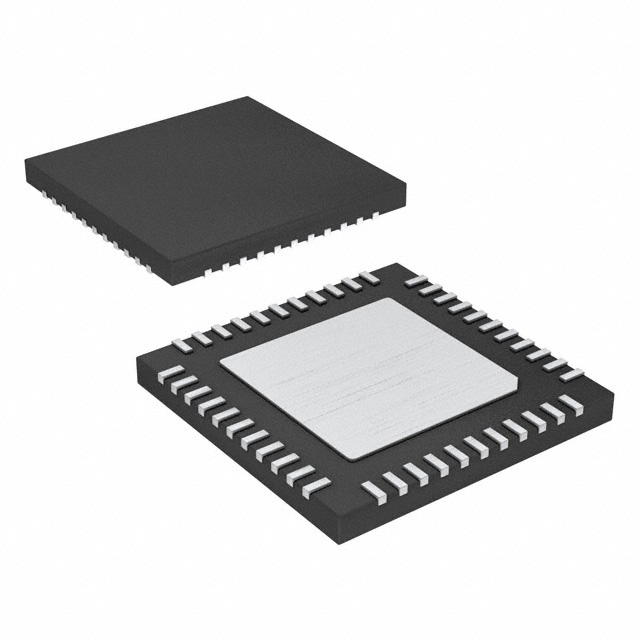ATMEGA164P-15MT1
Product Overview
Category
ATMEGA164P-15MT1 belongs to the category of microcontrollers.
Use
This product is commonly used in various electronic applications that require a microcontroller for processing and controlling functions.
Characteristics
- High-performance microcontroller with advanced features
- Low power consumption
- Wide operating voltage range
- Integrated peripherals for enhanced functionality
- Robust and reliable design
Package
ATMEGA164P-15MT1 is available in a compact surface-mount package, which facilitates easy integration into electronic circuits.
Essence
The essence of ATMEGA164P-15MT1 lies in its ability to provide efficient and reliable control and processing capabilities in electronic systems.
Packaging/Quantity
ATMEGA164P-15MT1 is typically packaged in reels or tubes, containing a specific quantity of microcontrollers per package. The exact packaging and quantity may vary depending on the supplier.
Specifications
- Microcontroller architecture: AVR
- Operating voltage: 2.7V to 5.5V
- Flash memory: 16KB
- RAM: 1KB
- EEPROM: 512 bytes
- Number of I/O pins: 32
- Communication interfaces: UART, SPI, I2C
- Clock speed: Up to 16MHz
- ADC channels: 8
- Timers/counters: 3
- Operating temperature range: -40°C to +85°C
Detailed Pin Configuration
The ATMEGA164P-15MT1 microcontroller has a total of 44 pins. The pin configuration is as follows:
- Pins 1-22: Digital I/O pins (PA0-PA7, PB0-PB7)
- Pins 23-30: Analog input pins (ADC0-ADC7)
- Pins 31-34: Power supply and ground pins (VCC, GND)
- Pins 35-38: Communication interface pins (RXD, TXD, SDA, SCL)
- Pins 39-42: Timer/counter pins (OC0A, OC0B, OC1A, OC1B)
- Pins 43-44: External interrupt pins (INT0, INT1)
Functional Features
- High-performance RISC architecture for efficient processing
- Advanced peripherals such as UART, SPI, and I2C for communication
- Analog-to-digital converter (ADC) for precise analog signal measurement
- Timers/counters for accurate timing and event control
- Interrupt handling for real-time responsiveness
- Power-saving modes for low power consumption
- In-system programming capability for easy firmware updates
Advantages and Disadvantages
Advantages
- High-performance capabilities for demanding applications
- Low power consumption for energy-efficient designs
- Wide operating voltage range for flexibility in various systems
- Integrated peripherals reduce the need for external components
- Robust design ensures reliability in harsh environments
Disadvantages
- Limited memory capacity compared to higher-end microcontrollers
- May require additional external components for certain applications
- Steeper learning curve for beginners due to advanced features
Working Principles
ATMEGA164P-15MT1 operates based on the AVR architecture. It executes instructions stored in its flash memory, processes data, and controls various functions in an electronic system. The microcontroller interacts with external devices through its I/O pins and communication interfaces. It can be programmed using a suitable development environment and programming tools.
Detailed Application Field Plans
ATMEGA164P-15MT1 finds applications in a wide range of fields, including but not limited to: - Industrial automation - Home automation - Consumer electronics - Automotive systems - Medical devices - Internet of Things (IoT) applications
In these fields, the microcontroller can be used for tasks such as sensor data acquisition, motor control, user interface management, communication protocols implementation, and more.
Detailed and Complete Alternative Models
Some alternative models to ATMEGA164P-15MT1 that offer similar functionalities include: - ATMEGA324P-15MT1 - ATMEGA644P-15MT1 - ATMEGA1284P-15MT1
These models provide varying memory capacities and additional features, catering to different application requirements.
Note: The content provided above is a sample structure for an encyclopedia entry. The actual content may vary based on specific product details and requirements.
قم بإدراج 10 أسئلة وإجابات شائعة تتعلق بتطبيق ATMEGA164P-15MT1 في الحلول التقنية
What is the operating voltage range of ATMEGA164P-15MT1?
- The operating voltage range of ATMEGA164P-15MT1 is 1.8V to 5.5V.What are the key features of ATMEGA164P-15MT1?
- Some key features of ATMEGA164P-15MT1 include 16KB of flash memory, 1KB of EEPROM, 512B of SRAM, and a wide operating voltage range.Can ATMEGA164P-15MT1 be used for low-power applications?
- Yes, ATMEGA164P-15MT1 is suitable for low-power applications due to its low power consumption and multiple sleep modes.What communication interfaces does ATMEGA164P-15MT1 support?
- ATMEGA164P-15MT1 supports USART, SPI, and I2C communication interfaces.Is ATMEGA164P-15MT1 suitable for industrial applications?
- Yes, ATMEGA164P-15MT1 is suitable for industrial applications due to its robust design and wide operating temperature range.What development tools are available for programming ATMEGA164P-15MT1?
- Development tools such as Atmel Studio and AVR-GCC can be used for programming ATMEGA164P-15MT1.Can ATMEGA164P-15MT1 be used in automotive electronics?
- Yes, ATMEGA164P-15MT1 is suitable for automotive electronics applications due to its reliability and temperature tolerance.What are the available package options for ATMEGA164P-15MT1?
- ATMEGA164P-15MT1 is available in various package options including TQFP, QFN, and MLF.Does ATMEGA164P-15MT1 have built-in analog-to-digital converters (ADC)?
- Yes, ATMEGA164P-15MT1 has a 10-bit ADC with multiple channels for analog input.Are there any application notes or reference designs available for using ATMEGA164P-15MT1 in technical solutions?
- Yes, there are application notes and reference designs provided by the manufacturer to assist in implementing ATMEGA164P-15MT1 in technical solutions.


